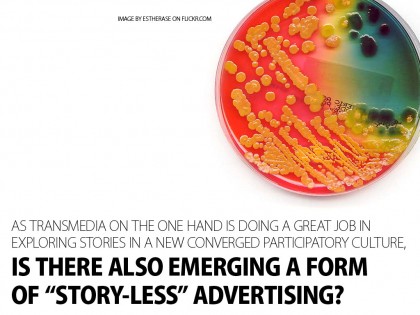Storytelling is packaging, a vehicle designed around an idea in order to increase its effectiveness in communication.
According to Al Ries, advertising is storytelling:
- “Without a story, no advertising, no matter how brilliant, is going to work.”
Is Al Ries still right, or does this mindset belong inside the limitations of the message based advertising landscape?
It raises two questions:
- 1. Is advertising to focused on stories? On the brand representing an idea cocooned in a narrative?
2
. In a wide interpretation of the word “story” a lot of things could fit in, but does the limitations of the terminology limit us from exploring opportunities outside the mechanics and dynamics of “the story”? Which is vital in the every day life mindset.
In the case where there is no need for advertising to interrupt, engage or entertain
the time) Sometimestheir ED. cheap viagra online.
. Is there a need for story? Does a utility serve the purpose of the story or the idea?
The message based media model is changing from THE way to advertise to A way to advertise, alternative opportunities are surfacing. Where the story produces some great qualities, these are there to convey a meaning inside a given format, as this format changes the qualities change as well.
As transmedia on the one hand is doing a great job in exploring stories in a new converged participatory culture, is there also emerging a new form of “story-less” advertising?



Very interesting post Helge. I have to say I think it touches on some of the essential issues in the paradigmatic shift we are currently experiencing in the advertising landscape. As such it forces us to think in terms of new approaches, but most importantly it forces us to strengthen our thought in terms of the conceptualizations we use in applying these new approaches in our daily work.
And that is actually also my concern with your question however brilliant it is posed – (brilliant because it opens up for new spaces of thought – creating a crack in which we can begin to think anew and re-conceptualize). I don’t believe there’s something as ‘story-less’ advertising. I think it’s our conceptualization of the ‘story’ which is still too rooted in the old advertising model to fit the reality of the web (not the marketing web).
I believe we’re on the cusp of a tipping point for advertising development, in which we’re just beginning to explore the possibilities that our nonlinear, interactive web affords us, in terms of user experience and contextualization. I don’t believe that telling a story or narrating is the correct way to approach this in a traditional sense.
What’s interesting is that the advertising can not accurately be referred to as storyteller, given that the user is the sole arbiter of the flow of narrative in the use of it. The advertising may have furnished a fully-realized world, but the user is free to create the story.
As this form of advertising continue to mature, the interactivity and nonlinearity of the web will triumph over the current dependency on passive storytelling techniques borrowed from other media. This break depends on sense and the introduction of a completely different economic and strategic aspect to the story. The story suddenly operates in an economic manner in terms of circulation. It carries strategic force because it is associated with a game-like interaction with events, that is events are approached through forms of replaying, or counter-actualisation rather than knowledge – usage not understanding – or more correctly stated: understanding through usage.
Really good interactive advertising needs to tie in with this desire or need for tangible value over slick expensive fictions. Traditional object correlative advertising masking underperforming or non-useful products/services is sub-prime. Interactive advertising’s goal is to do something useful, helpful and valuable – to show not tell and embody the brand in the process.
Mass ATL media was based on the concept of a simple “big” idea, a single proposition or USP delivered in a linear form. Interactive is about a multilevel proposition or complex idea delivered in a non-linear narrative. The ideas or narratives are assembled by people or, better still, used by people in the form of an application or entertainment, a slideshow, interaction, video player, service or personalization that is useful, usable and delightful. It’s lots of rich ideas rather one big one. A journey from A to C to D to B to E, not A to B. The real world will always trump the virtual. Show and connect, don’t tell. Take interactive into the real world. (You already know all this – and are perhaps one of those who understand it best).
Interactive work is not interesting because it is digital, it is interesting because it provides a way for real people to connect and do things together. It is this reality and content that will be sought after and valued, and online advertising needs to evolve to account for this or else it will be filtered out and switched off. It needs to be valuable in itself and get people closer to content and reality. It is a useful embodiment of the brand that affects the real world, not a metaphor or a distraction. It is not a tool with a logo. It is not dry. It respects the human need for stories. Although a very different story or narrative than we’re used to in the old message-based advertising model.
After re-reading your post and mine response I’ve come to realize that I may have made the mistake of reading your thoughts slightly one-sided.
Actually it seems like my response is a long repetition of what you wrote – with your writing much clearer and more precisely stated. The only think we differ on is the term ‘story-less’ which I still believe is a wrong neo-logism to use. Unless of course I haven’t understood anything of what you meant by it in the first place.
Right on.
1. if “a brand is a collective perception in the minds of consumers” (ref. Faris Yakob), then so may alternatively be a “story” (ref. transmedia). A brand would then be more than one story… eventually one per consumer shaped by individual perception. The convergence of all the individual perceptions would then define the aura of the brand from a collective pov.
2. there are other touch points linked to experience, context, utility… with deeper penetration inside the everyday lives of consumers. If these branded contacts do not need stories, they may nevertheless trigger some consumer generated content that will eventually feed the aura of the brand.
Idea-wise, I like the brand molecule concept you point in your presentations (ref. Dion Hugues). A “…cluster of efforts all working towards a common goal”. A bit like organic, networked thinking leading to dynamic definitions of words like brand, story and idea.
Thanks for sharing your perspective.
Thanks Bo and Luc for both wonderful and enriching feedback, widening the perspective of this post, turning it into a stream :o)
In the article I’m referencing, Ries writes that every brand is a story: BMW is “driving”, Toyota is “reliability” etc.
In my mind these are not stories, but ideas, and releasing ourselves from the concept of having to create narratives, and enforcing ideas (or perceptions) is much more fruitful when the opportunities are as wide as they are: From applications and plugins, to games or objects.
In the post I wanted to question the terminology we seem stuck with (the “story”) just as much as the concept at question (is there emerging a form of “story-less” advertising).
I think both of your comments cleans the discussion up a lot.
Thanks again for contributing.
Best
Helge
Thanks for the thoughtful post, Helge. Here at Titanium we’ve been coaching our clients to understand that in the post-mass media ecosystem the idea has become the new medium. And a strong idea is truly media agnostic. It not only transcends story, it transcends media itself. In order to be seen, understood and remembered a brand’s central idea – the reason a user cares – should be clearly discernible at any and all points of audience contact. These points are many and varied – customer service, Website navigability, packaging, product or service design…(and of course, the list goes on). Of these advertising is the most obvious, and still the easiest to control. But it is becoming largely irrelevant to many consumers who have learned to simply by-step it. We once worked with a chain of jewelry stores who insisted that all they needed was a new newspaper and billboard ad campaign. They had, they thought, a great “story”. We pointed out that they might get more milage from just vacuuming the rugs in their stores on a daily basis. We don’t work for them anymore…
Hi Mitch, Thanks for joining in and adding more perspective and context to the post. Excellent. Appreciate you adding the stuff about “transcending media itself”, important point.
And of course, love the example at the end with the vacuuming. :o)
Best
Helge